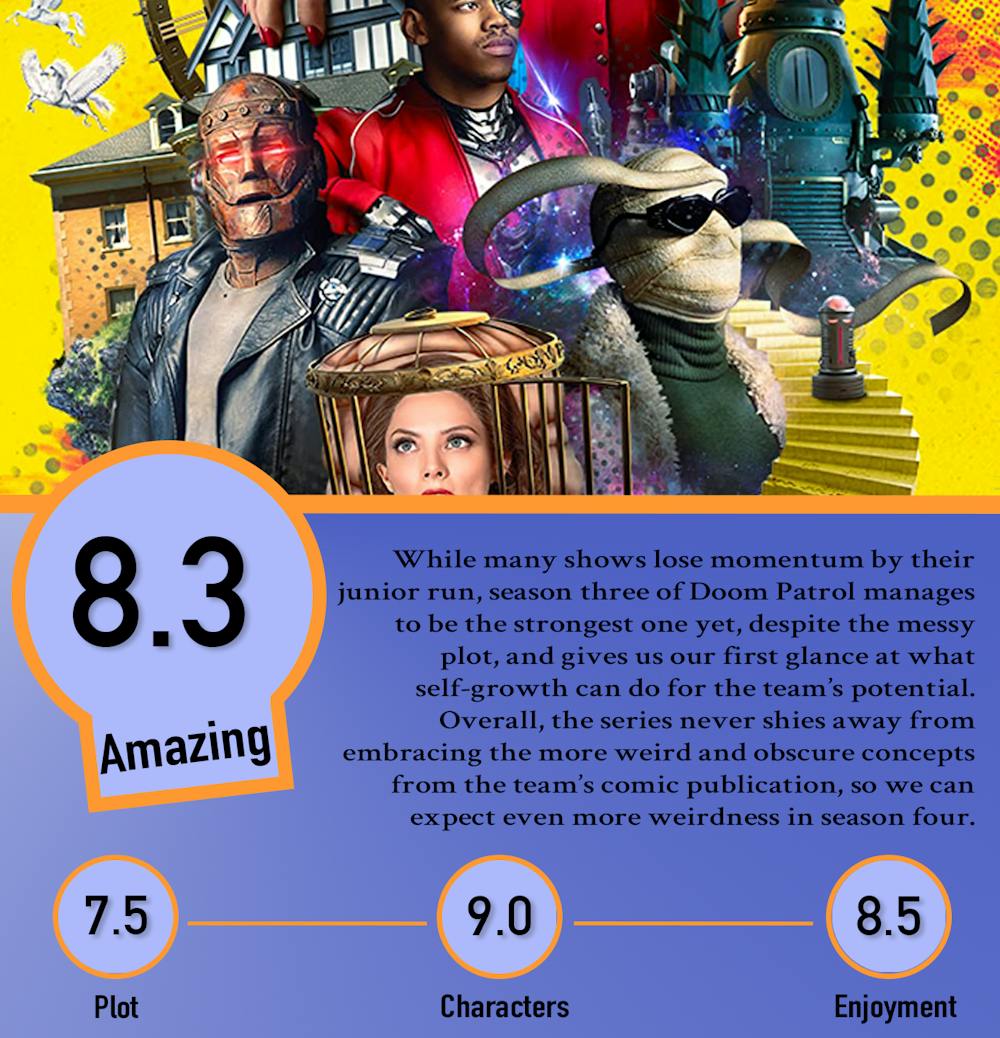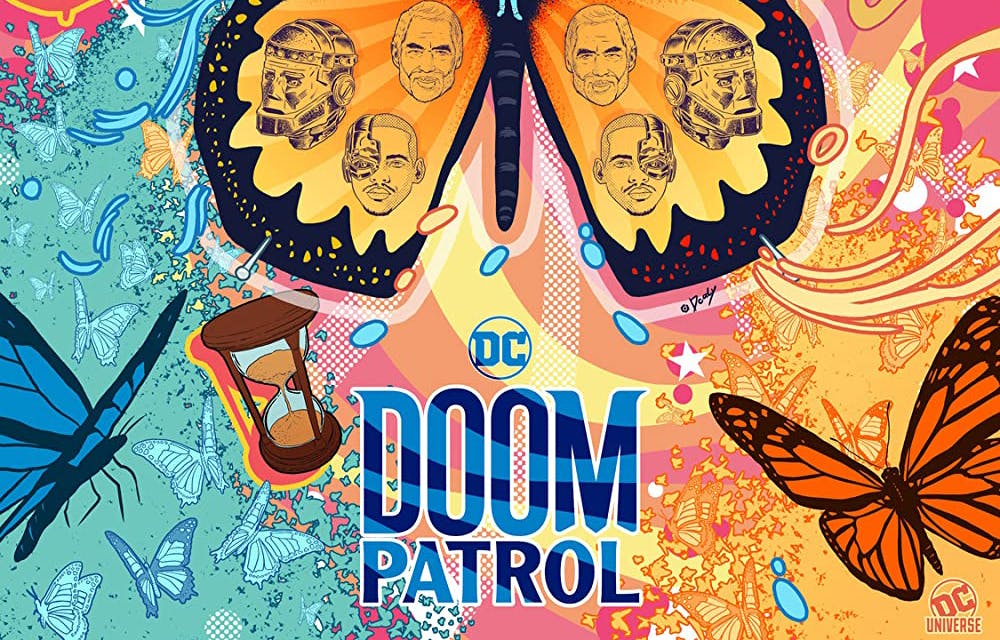Warning: this review contains spoilers for Doom Patrol Season 3
A spin-off of the late DC Universe (now HBO MAX) series Titans, 2019’s Doom Patrol has managed to carve its unique place and footing in the staggering repertoire of live-action adaptations of superhero comics. The series focuses on the exploits of a group of dysfunctional, super-powered individuals under the supervision of Niles Caulder—better known as “The Chief''—as they reside in the Doom Manor. After Chief is captured by his greatest enemy Mr. Nobody, an evil omnipresent narrator for the first season, the Doom Patrol finds themselves hopelessly unprepared as they look for Chief while having to come to terms with their own personal issues.
Season three’s arrival this year manages to bring even more complication to the messy lives of our heroes as they are met with the arrival of an amnesiac woman, known as Laura De Mille, looking for Chief, and the Sisterhood of Dada, a group of even weirder super-powered individuals determined to bring upon the Eternal Flagellation.
Yet underneath the bizarre elements of the show, the core root of the show is the examination of trauma and personal identity, which sets the show apart from the formulaic, often hollow tradition live-action media in the superhero genre have been plagued with. The Doom Patrol are not your typical altruistic heroes; they’re pragmatic, often self-centered, and stuck in cycles of unhealthy coping mechanisms. However, they are trying and have spent the last two seasons accepting their issues and working toward mastering their powers. With a splash of new colorful characters and adventures awaiting, season three has only further enriched the character’s commitment to self-betterment and leaves the team closer to being a fully-fledged superhero team more than ever.
Fun, but messy plotline
Due to COVID-19 shutting down production in March of last year, season three begins only seconds after season two’s ending as the planned 10-episode run was cut to nine episodes. So, the first episode of the season focuses on tying up loose threads, such as Chief’s daughter Dorothy facing the Candlemaker, a rogue imaginary friend that she is capable of conjuring up in reality, and the team’s quest to find a way to increase the Chief’s longevity as he is revealed to be slowly dying. There is also another loose thread for Jane’s arc throughout season two, as she deals with the reemergence of former primary Miranda who is slowly killing off personalities to heal Kay. The first episode wraps these plotlines in a rushed, anticlimactic way that betrays the dramatic momentum the cliffhanger brought. However, it leaves the new season with new circumstances for the team: the stress from the fight has caused the Chief’s heart to go out, leaving him dead and the team alone without a leader once again.

Image from IMDB
Well, he’s not completely gone. Dorothy won’t put his body to rest, so he’s stuck as a ghost until he can manage to get someone in Doom Manor to convince her to destroy his body, but he doesn’t have much luck since the team is either too busy with their own problems or refuses to help. They can’t be blamed, since they’re all in different ways still grappling with Chief’s betrayal, as his quest for immortality led him to orchestrate the events that caused them to gain their powers and subsequently ruin their lives. However, they have to come together to be there for his young daughter and help her let go, just as Chief did for them in the Doom Manor. Once that’s out of the way, a brief vacation and sudden appearance of a time-traveler named Laura De Mille spring the team into even more absurd adventures as she has no recollection other than a quest for which she needs the Doom Patrol to kill the Sisterhood of Dada, though they are once again reluctant as they are too busy dealing with their problems.
Season three introduces plenty of new characters that mesh well with the overall absurdity of the show. There’s Garguax, an alien assigned to kill Rita, a former actress who struggles to maintain her shape, though years of waiting for her arrival have caused him to give up on those plans and become a well-known member of the rich country club the team arrives at for vacation. There are also new recurring villains such as The Brain, the leader of the Brotherhood of Evil, and his right-hand man Monsieur Mallah, a talking gorilla, who bring their problems and shenanigans to the plot.

Image from IMDB
This is in part due to the series’ semi-villain-of-the-day story structure, which allows it to adapt characters connected to the Doom Patrol’s extensive comic mythos without the narrative feeling bloated or overwhelmed, and these characters often get an entire episode worth of time to be fleshed out. However, due to this, the plot can sometimes feel disjointed, and that can mostly be attributed to the cause-and-effect nature of the narrative. For example, the team is fatally killed during their vacation by Garguax’s rouge assistant, and spend the next episode attempting to return to the living. They manage to do so by the end, but unfortunately, become zombies in the next episode and have to eat the flesh of Chief’s head to return to normal (which they all agree to never speak of again). Major events like this don’t contribute to the progression of the plot, so it feels that the characters are thrown around throughout the season in between moments dedicated to their character arcs.
Who you are, What you are, Why you are
Doom Patrol has always been very character-driven, so it's no surprise that the best part of the season is the characters and their arcs. In season one, the team explored their trauma together, even having a mini therapy session to air out each other’s baggage, but season three has continued the trend established in the show’s sophomore run where the team is often away from each other while they grapple with their problems. The core focus of their arcs this season is finding their footing after Chief’s death, which they are all handling in their own way. Cliff, a former race car driver turned robot, embraces grandfatherhood to make up for lost time with his daughter while dealing with symptoms of Parkinson's; Larry—a disfigured pilot wrapped in bandages—ventures into space with his negative spirit; Jane focuses on encouraging Kay to heal while Jane eases tension between her other personalities; Vic grapples with his own identity as a superhero and whether becoming Cyborg was his choice or his father’s wish for him.
“Who you are?,” “What you are?,” and “Why you are?” are recurring motifs in the season, and are the very questions that the team finds themselves up against. This is especially evident in episode eight, “Subconscious Patrol,” as the Eternal Flagellation causes the team to relive their deepest, most shameful secrets and just how much have they been avoiding dealing with the core root of their problem. It's arguably one of the most uncomfortable and vulnerable episodes in the series to date, yet the stellar acting and writing show just how far our beloved team has come.

Image from IMDB
This is most evident with Rita, and her growth is astronomical this season. Unlike the rest of the cast, she feels the weight of Chief’s death the most. He leaves her instructions on how to lead the team, but how can she do that if she doesn’t even know her direction without him? Rita finds that through most of her life she has relied on others to make the decisions for her, and this makes her development so much sweeter as she comes to terms with her indecisiveness. A rash decision to travel back to the past leaves her without her memories, but this result allows her to navigate life in the past riddled with guilt and trauma. Rita finds herself in the company of the Sisterhood of Dada, who are just as eccentric and human as the team, and even finds true love. Sadly, this doesn’t last, but Rita comes back to the present more sure of herself than before and even becomes the leader of the team in her own right.
Another stand-out character was the introduction of Laura De Mille, who is later revealed to be a power-hungry villain known as Madame Rouge (who has a history with the team in the comics) that betrayed Rita and the Sisterhood of Dada in the past. Laura grapples with her ability to change for the better, and after some encouragement from Cliff, she begins her adventure with the team to see if she can find her place and identity. What could have been a cliche, hero versus villain fight in the final episode, ends up being an important message that everyone is capable of being redeemed.
Finally a superhero team?
Even though the series is a part of the superhero genre, the Doom Patrol has never been an actual team, even going so far as to make it clear that our heroes are not ready for the hero's life. In the final episode, Rita makes it clear to the team that they’re done letting themselves be defined by labels other subscribed to them such as “misfit,” and this springs the team to start their journey of heroic feats.
They’ll probably still fail, get caught up with their issues, and squabble like any family does, but they’ll still rise to any occasion. Maybe all that's anyone needs to do to take the first steps to self-improvement in our hands. Overall, this season brought the team closer to Chief’s goal of a super team than before. Sure, we don't know how this new step will affect the team and how season four will address some of the loose ends from the final episode, but for now, all three seasons of Doom Patrol are available to stream on HBO Max.

Images: IMDB
Featured Image: IMDB




















